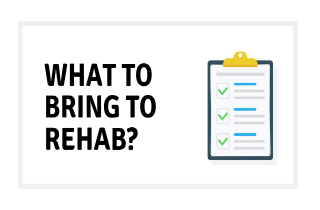Q: What’s the most important thing to bring with you to rehab?
A: Willingness to learn and to change.
Here, you’ll find a checklist list of practical items you can bring with you, too. Plus, some tips on how to prepare for treatment for alcoholism problems. Then, we invite your questions or comments in the section at the end.
Preparing for rehab: Is rehab right for you?
Doctors have developed a list of symptoms that a person has to have exhibited in the past year to be diagnosed with alcohol use disorder. Symptoms of alcoholism include:
- Alcohol use causes you to miss work or school, or results in decreases in performance
- Continuing to drink despite negative consequences to home, social, or work life
- Craving alcohol or having a strong urge to drink
- Needing more and more alcohol to feel its effects or to get drunk (increased tolerance)
- Spending a lot of time and effort to get alcohol, use it, or recover from its effects
- Wanting to, or trying to, cut down or stop drinking…but failing
Another common symptom of a problem is (paradoxically) denial. Most problem drinkers and alcoholics deny they have a problem. As they develop dependence on alcohol, they also develop “blinders”, a defense system that allows them to ignore the problem. They want to blame their problems on something or someone else: bad luck, a misunderstanding spouse, a supervisor who doesn’t like them, etc.
Q: So, is alcohol rehab for you?
A: If you think you have a problem with drinking, you probably do.
Keep in mind that the earlier the treatment, the more successful it is likely to be. Don’t wait until the health effects are irreversible, you have lost your job, or your marriage has suffered to the point of breaking up. Getting help for alcoholism starts with knowing that you have a problem. Willingness to face the problem shows a good start!
Stages and methods of alcoholism rehab centers
Rehab for alcoholism follows a basic protocol.
1. Assessment
2. Withdrawal/Medical detox (when necessary)
3. Treatments: Psychotherapy and Pharmacotherapy
4. Transition and aftercare
Alcoholism rehab centers checklist
What should you bring with you to an rehab that treats alcoholism? You’ll probably need to bring the following items:
1. Prescription medication in the pharmacy container
2. Over the counter medication in the original container
3. Medicaid, Medicare card, or private insurance information
- simple, modest clothing appropriate to the weather
- comfortable walking shoes
- deodorant
- disposable razor
- family photos
- hair dryer, curling iron, comb, brush
- jacket/coat/sweater/sweatshirt appropriate to the weather
- personal hygiene items (bath soap, shampoo, shaving cream hand or body lotion)
- pillow or other sleeping comfort items
- souvenirs or inspirational items
- stationary/envelopes/stamps/pens/paper/notebook
- tampons/sanitary napkins
- toothbrush and toothpaste
- umbrella or other rain protection
Staff usually provide whatever assistance is necessary to help you get cleaned up after entering the facility and bathed as soon as you have been medically stabilized. Towels, sheets, and other basic hygienic care should be provided by the rehab center. Food, snacks, and regular meals will also be provided.
Getting started: The work of rehab
Many people are afraid because they don’t know what to expect in the alcohol rehab process, and we agree that being aware of the steps in the process is very useful. Within the rehab center, one of the first things that happens after detox is the creation of a “recovery plan”. Sometimes it is called a treatment plan or service plan and it is the document that you create with your team to help plan how you want to move forward towards your goals. It is used to decide on:
- goals that are important to you in your recovery and well-being
- the actions that you personally need to take to make progress toward these goals
- the types of services and support your team can offer to help you achieve these goals
A treatment plan will also be used by your mental health team so they can document the treatment modalities they provide to you. This will help you to start identifying some of the areas of your life that you want to work on, and how to talk to your team about planning for next steps. Assessment and revision of the treatment plan happens on a regular basis – usually every 6 months (although the plan can be updated as needed). You can usually invite anyone you would like to have involved in the creation of this plan. This can include professional staff (e.g., such as doctors or therapists) as well as friends or family members.
Questions about alcoholism rehab?
Do you still have questions about what to bring with you or about what happens during rehab treatment for alcoholism? Please leave us your questions or comments in the section below. We’ll do our best to respond to you personally and promptly.









Related Posts